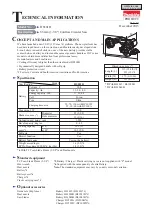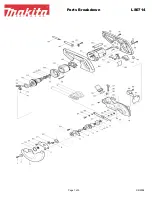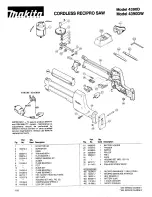
9
ENG905-1
Noise
The typical A-weighted noise level determined
according to EN61029:
Sound pressure level (L
pA
) : 91 dB (A)
Sound power level (L
WA
) : 108 dB (A)
Uncertainty (K) : 3 dB (A)
Wear ear protection
ENG900-1
Vibration
The vibration total value (tri-axial vector sum)
determined according to EN61029:
Vibration emission (a
h
) : 2.5 m/s
2
or less
Uncertainty (K) : 1.5 m/s
2
ENG901-1
•
The declared vibration emission value has been
measured in accordance with the standard test
method and may be used for comparing one tool
with another.
•
The declared vibration emission value may also be
used in a preliminary assessment of exposure.
WARNING:
•
The vibration emission during actual use of the
power tool can differ from the declared emission
value depending on the ways in which the tool is
used.
•
Be sure to identify safety measures to protect the
operator that are based on an estimation of
exposure in the actual conditions of use (taking
account of all parts of the operating cycle such as
the times when the tool is switched off and when it
is running idle in addition to the trigger time).
ENH003-15
For European countries only
EC Declaration of Conformity
Makita declares that the following Machine(s):
Designation of Machine:
Flip over saw
Model No./ Type: LF1000
Conforms to the following European Directives:
2006/42/EC
They are manufactured in accordance with the following
standard or standardized documents:
EN61029
The technical file in accordance with 2006/42/EC is
available from:
Makita, Jan-Baptist Vinkstraat 2, 3070, Belgium
30.10.2014
000331
Yasushi Fukaya
Director
Makita, Jan-Baptist Vinkstraat 2, 3070, Belgium
GEA010-1
General Power Tool Safety
Warnings
WARNING Read all safety warnings and all
instructions.
Failure to follow the warnings and
instructions may result in electric shock, fire and/or
serious injury.
Save all warnings and instructions for
future reference.
ENB094-6
FLIP OVER SAW SAFETY
WARNINGS
FOR BOTH MITER SAW MODE AND TABLE SAW
(BENCH SAW) MODE:
1.
Check the blade carefully for cracks or
deformation before operation.
Replace damaged blade immediately.
2.
Do not operate saw without guards and riving
knife in place, especially after a mode change.
Check blade guards for proper closing before
each use. Do not operate saw if blade guards
do not move freely and close instantly. Never
clamp or tie the blade guards into the open
position. Any irregular operation of the blade
guards should be corrected immediately.
3.
Use only saw blades specified by the
manufacturer and which conform to EN847-1.
The groove width of the cut must be thicker
than the riving knife and the blade body must
be thinner than the riving knife.
4.
Do not use saw blades manufactured from
high speed steel.
5.
Wear eye protection.
6.
Wear hearing protection to reduce the risk of
hearing loss.
7.
Wear gloves for handling saw blades (saw
blades shall be carried in a holder wherever
practicable) and rough material.
8.
Connect the tool to a dust collecting device
when sawing.
9.
Always store the push-stick when it is not in
use.
10.
Keep the floor area around the tool level well
maintained and free of loose materials e.g.
chips and cut-offs.










































